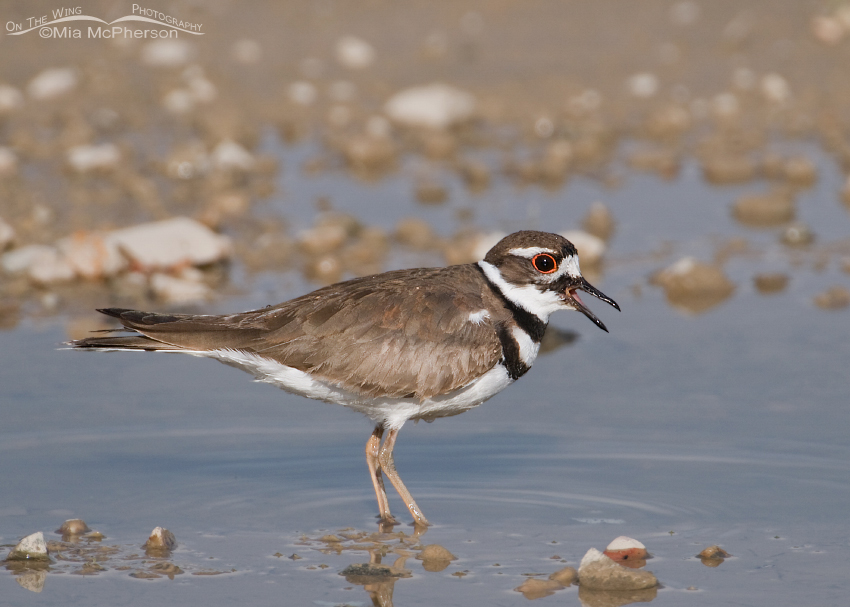I must admit that when I first saw the Mountain Plovers I reported on Antelope Island State Park I knew exactly what I was looking at because I had dreamed of seeing Mountain Plovers and had studied their appearance in every guidebook and app that I own.
 Killdeer calling at Farmington Bay WMA
Killdeer calling at Farmington Bay WMA
Even though I was looking at a tiny bird that was about a football field and a half away in distance and the light on the bird was bad, I knew I was seeing a bird I had longed to see.
But there are a few similar species that occur in Utah and surrounding states that could be confused with Mountain Plovers. Killdeer look similar but there are some key ID features that help with identification. Killdeer have very dark breast bands, a red orbital ring around very dark eyes, a black collar that encircles the neck, a dark cheek patch (auriculars), brownish upper parts, white belly and a brownish crown.
 Mountain Plover in spring grasses
Mountain Plover in spring grasses
Mountain Plovers lack the double breast bands, the red orbital ring around the eyes. They have light colored auriculars, sandy brown upper parts, a black line that runs from the bill to the eyes in breeding plumage, black crown with a white forehead and a pale belly. Mountain Plovers also lack the double breast band that is unique to Killdeer.
Both birds do have thin, black bills.
 Black-bellied Plover at Fort De Soto
Black-bellied Plover at Fort De Soto
It would be easy to see the differences between a Mountain Plover and a Black-bellied Plover in breeding plumage but at long distances Black-bellied Plovers in nonbreeding plumage could possibly be mistaken for Mountain Plovers. Black-bellied Plovers are larger but at a distance that would be hard to see.
Black-bellied Plovers have a thicker, longer bill than Mountain Plovers do. They have checkered upper parts, darker legs and their chest can have streaks on it. Their bodies also appear more rounded than Mountain Plovers.
 Mountain Plover delight
Mountain Plover delight
It always helps to have high quality images to use in making ID’s but there are times that is not possible and at that point any photo is better than none. It would also help to make notes on the size, shape, color, behavior and other ID keys such as size of the bill, plumage patterns, leg length and color and more.
Recently on the ABA Rare Bird Alert Facebook page there was a possible Mountain Plover reported in Jasper County, South Carolina that had an interesting discussion on the reported sighting where the ID has been decided that it was an American Golden Plover. The sighting was posted on April 16th but photographed the same day as the pair I found, identified, pointed out, and photographed on Antelope Island, Utah. I found the discussion interesting.
Bird identification can be fun and very challenging, sometimes more challenging than not. With these Mountain Plovers comparing two similar looking species ahead of time can make identification in the field easier.
Life is good.
Click here to see more of my Mountain Plover photos plus facts and information about this species.
Mia


Thanks for all of your comments on this post.
Sally, I hope you figure out what the mystery birds are.
I think the mystery birds in the grass might be Bobwhites.
You know Sally, they might be!
Hi! loved seeing and hearing the Killdeer when I was growing up! Great photo’s. Have a great day!
Excellent comparison photographs and identification assistance. All are beautiful birds! Superb photographs, Mia!
beautifull serie, great close up on each one, well done mia
We may have, and I may have seen, Killdeer here in Central Il. And I have seen what I thought to be Killdeer. But there is a mystery bird in the prairie grass I have seen flushed out in summer, on late afternoons, and I don’t know what they are. They fly out quickly, about 4 0r 5 feet up and disappear into the grass again. Hope to see them some more, but they do so many burns around here, I shouldn’t wonder if it doesn’t do them a harm.
Great tips and excellent photos, Mia!
As always, I’ve learned something new by enjoying your blog, Mia. And such gorgeous photos…
Great Plovers night, they are magnificent, cheers Mia.
Nice post on identification tips! Timely, too, since I was challenged by Plovers in varying degrees of plumage the other day at Ft. De Soto.
Nice comparison and I’m with you, any photograph is helpful for ids! Thank doG for digital. Now I’m going to have to watch and see if we get any mountain plovers around here. We are thick with killdeer tho!